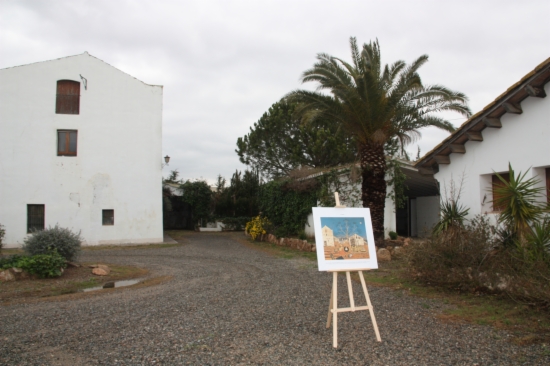Joan Miró's family farmhouse in southern Catalonia to be converted into a museum by 2016
The country house where one of the world's greatest artists of the 20th century, Joan Miró, spent his summers in his teenage and adult years will be transformed into a museum. The Mas Miró, the artist's family farmhouse located in Mont-roig del Camp, in the Catalan Province of Tarragona, will be open for visitors by summer 2016. The project – developed by RCR and Varis Arquitectes studios – will consist of two phases. The first – costing a total of €2.5 million – entails the conversion of the farmhouse and the painter's studio into a museum, the renovation of the housekeeper's house and the construction of an entry pavilion. The second – which will cost €3 million – envisages the creation of new areas such as: a restaurant, a new car park, a multipurpose room and a workshop space. Work is due to start in the coming weeks.

Barcelona (ACN).- The country house where one of the world's greatest artists of the 20th century, Joan Miró, spent his summers in his teenage and adult years will be transformed into a museum. The Mas Miró, the artist's family farmhouse located in Mont-roig del Camp, in the Catalan Province of Tarragona, will be open for visitors by summer 2016. The project – developed by RCR and Varis Arquitectes studios – will consist of two phases. The first – costing a total of €2.5 million – entails the conversion of the farmhouse and the painter's studio into a museum, the renovation of the housekeeper's house and the construction of an entry pavilion. The second – which will cost €3 million – envisages the creation of new areas such as: a restaurant, a new car park, a multipurpose room and a workshop space. Work is due to start in the coming weeks.
In Catalan, the word Mas means traditional farm or country house, and the word Masia is used for its main building. The Mas Miró is a farmhouse that Joan Miró's family bought in 1911 from a local nobleman. The property is located just outside Mont-roig del Camp, between the sea and the village. The Catalan artist spent long periods of his life there (especially during the summer), for nearly 65 years. As explained by his grandson Joan Punyet Miró, the painter himself wanted to convert it into a museum. "He died without being able to make it happen. My goal is to make my grandfather's dream come true". Punyet underlined both the artistic and economic relevance of the project, which aims at making Mont-roig an integral part of the "Mironian world" and attracting visitors from all over the world.
The first phase of the transformation project will entail the renovation of the family house, the painter's studio and the housekeeper's house, as well as the construction of an access pavilion. The underlying goal will be to stress Miró's bond with the village of Mont-roig. The entry pavilion will host a reception, a shop and the museum offices.
Once the museum is open to the public, the tour of the painter's studio will be divided into two parts. The first – outside the actual room – will include pictures (from Joaquim Gomis' archives) and some of the artist's letters. The second – inside the studio – will allow visitors to see two pieces of wall graffiti and a space dedicated to objects which inspired Miró's sculptures. In addition to this, the farmhouse will be transformed into an information point and screening room. In order to plan the renovation of the external part of the museum, the architects drew inspiration from one of the artist's most famous paintings, 'La Masia' (1921-1922).
The second phase of the project envisages the construction of new areas such as two multipurpose rooms for educational and recreational activities, a restaurant and a car park.
The first phase of the work has already begun with the cleaning of the building and its surroundings. The Mas Miró has been closed for five years and the goal of the conversion project is to have the museum ready by summer 2016. The work has been funded by the Mas Miró Foundation (through some partner entities) and the Mont-roig Town Hall is trying to obtain a 1% contribution from the Catalan Ministry of Culture, explained Mayor Ferran Pellicer.
Both Miró's descendants and representatives of the Joan Miró Foundation in Barcelona believe that there is a good chance that the project will be successful. "This house is like a journey into the past and we are lucky that it is located in Mont-Roig. The duo Miró-Mont-Roig is a winning combination", said the artist's grandson, Joan Punyet.
Jaume Freixa, President of the Joan Miró Foundation in Barcelona, labeled the reconversion project as "ideal" because it will allow visitors to know the environment where the artist created his works. On the same note, the Director of the Foundation, Rosa Maria Malet, explained that, with the renovation of the Mas Miró, the Mironian triangle (Barcelona, Mallorca and Mont-roig) will be complete, giving value to such a crucial place for the artist.
The Mas Miró Foundation, established on 15 March 2013, is the promoter of the reconversion project and the opening of the farmhouse to the public as the artist's house. It is supported by the Joan Miró Foundation, Successió Miró S.L – a company formed in 1996 by the heirs of Joan Miró to administer the rights of the artist's works – and the Town Hall of Mont-roig.
Joan Miró was born in Barcelona on 20 April 1893 and died in Palma de Mallorca on 25 December 1983. Barcelona, Mallorca and Mont-roig can be defined as the Mironian magic triangle.